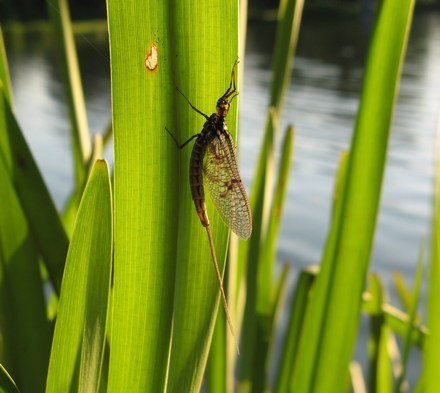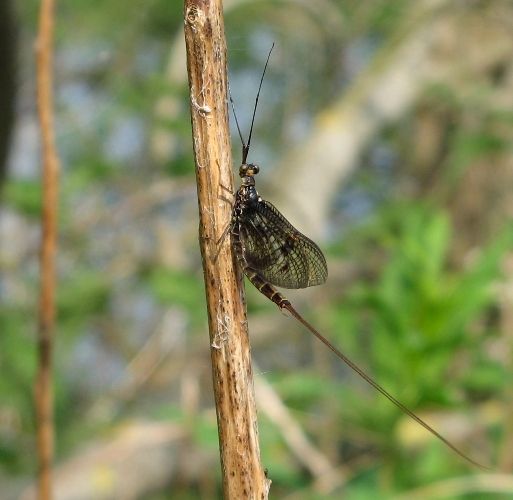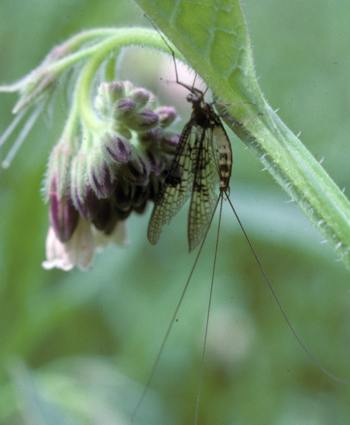
Habitat
Two main criteria must be met in order for
mayflies to develop through their entire life cycle, a body of
water for reproduction and vegetation to feed on. This
means that any environment that satisfies these two conditions
is a potential habitat for mayflies. Rivers and lakes in
particular are popular habitats. This means that mayflies
can be found all over the world! Some species exhibit
habitat preference when it comes to the type of sediment at the
bottom of the river or lake due to specifications of egg and
nymph development. Psammophilous mayflies for
example prefer river beds comprised of compact substratum,
which in situations with slow current also has a layer of silt
on top (Orwin, 2009). Silty-sand river bottoms
must be met in order for
mayflies to develop through their entire life cycle, a body of
water for reproduction and vegetation to feed on. This
means that any environment that satisfies these two conditions
is a potential habitat for mayflies. Rivers and lakes in
particular are popular habitats. This means that mayflies
can be found all over the world! Some species exhibit
habitat preference when it comes to the type of sediment at the
bottom of the river or lake due to specifications of egg and
nymph development. Psammophilous mayflies for
example prefer river beds comprised of compact substratum,
which in situations with slow current also has a layer of silt
on top (Orwin, 2009). Silty-sand river bottoms  are
colonized more by the Procloeon nana nymphs, and
Cercobrachys minutes nymphs are typically found on either
silty-sandy bottoms or on compact, shifting sand (Orwin, 2009).
These different niches are formed due to preference of the river
bottom. Some species prefer to live on substrata or wood
fragments that are displaced by the water current, and other
species prefer to live on compact substrata or plants which
would lead to less drifting. The mayflies are not the only
ones to occupy river and lake bottoms, besides mayflies numerous oligochaetes, chrinomids, and
bivalves can be found there as well (Orwin, 2009).
are
colonized more by the Procloeon nana nymphs, and
Cercobrachys minutes nymphs are typically found on either
silty-sandy bottoms or on compact, shifting sand (Orwin, 2009).
These different niches are formed due to preference of the river
bottom. Some species prefer to live on substrata or wood
fragments that are displaced by the water current, and other
species prefer to live on compact substrata or plants which
would lead to less drifting. The mayflies are not the only
ones to occupy river and lake bottoms, besides mayflies numerous oligochaetes, chrinomids, and
bivalves can be found there as well (Orwin, 2009).
Once the ma yflies molt passed the nymph stage and enter the subimago and imago stages, they take to the air and shelters
nearby to complete their development and lay eggs. These
changes in scenery throughout their life cycles leads to
interactions with a multitude of different organisms as well has
foster unique developments between species.
Several species of mayfly have developed adaptations that help them along
with development based on their specific habitats. To
learn more about these specific
adaptations visit the adaptations page. To view
organisms that share these similar types of habitats visit the
damselfly page on multiple organisms.net.
yflies molt passed the nymph stage and enter the subimago and imago stages, they take to the air and shelters
nearby to complete their development and lay eggs. These
changes in scenery throughout their life cycles leads to
interactions with a multitude of different organisms as well has
foster unique developments between species.
Several species of mayfly have developed adaptations that help them along
with development based on their specific habitats. To
learn more about these specific
adaptations visit the adaptations page. To view
organisms that share these similar types of habitats visit the
damselfly page on multiple organisms.net.
Back to homepage